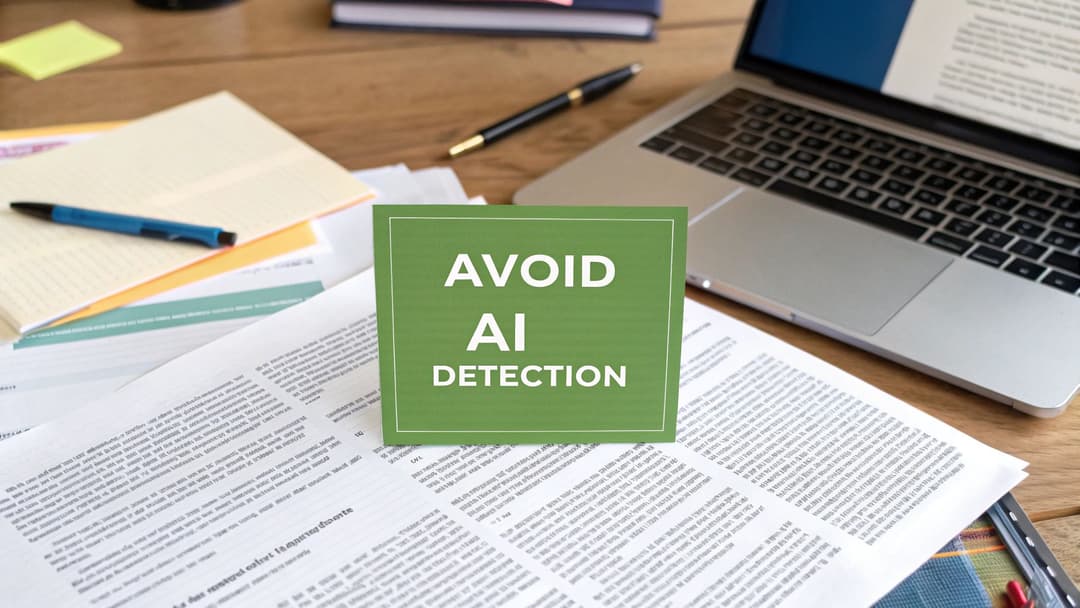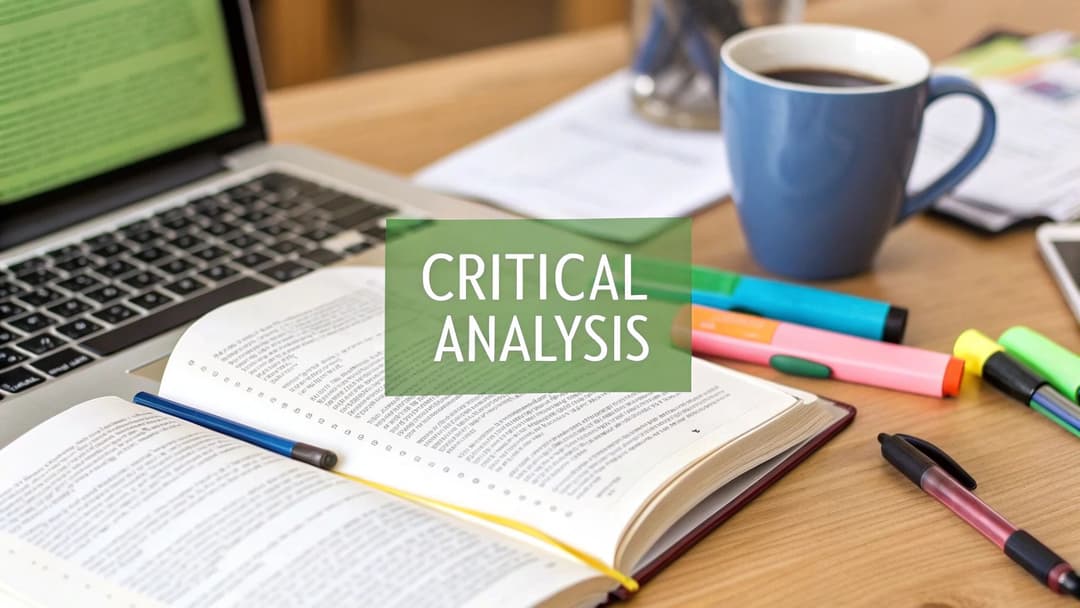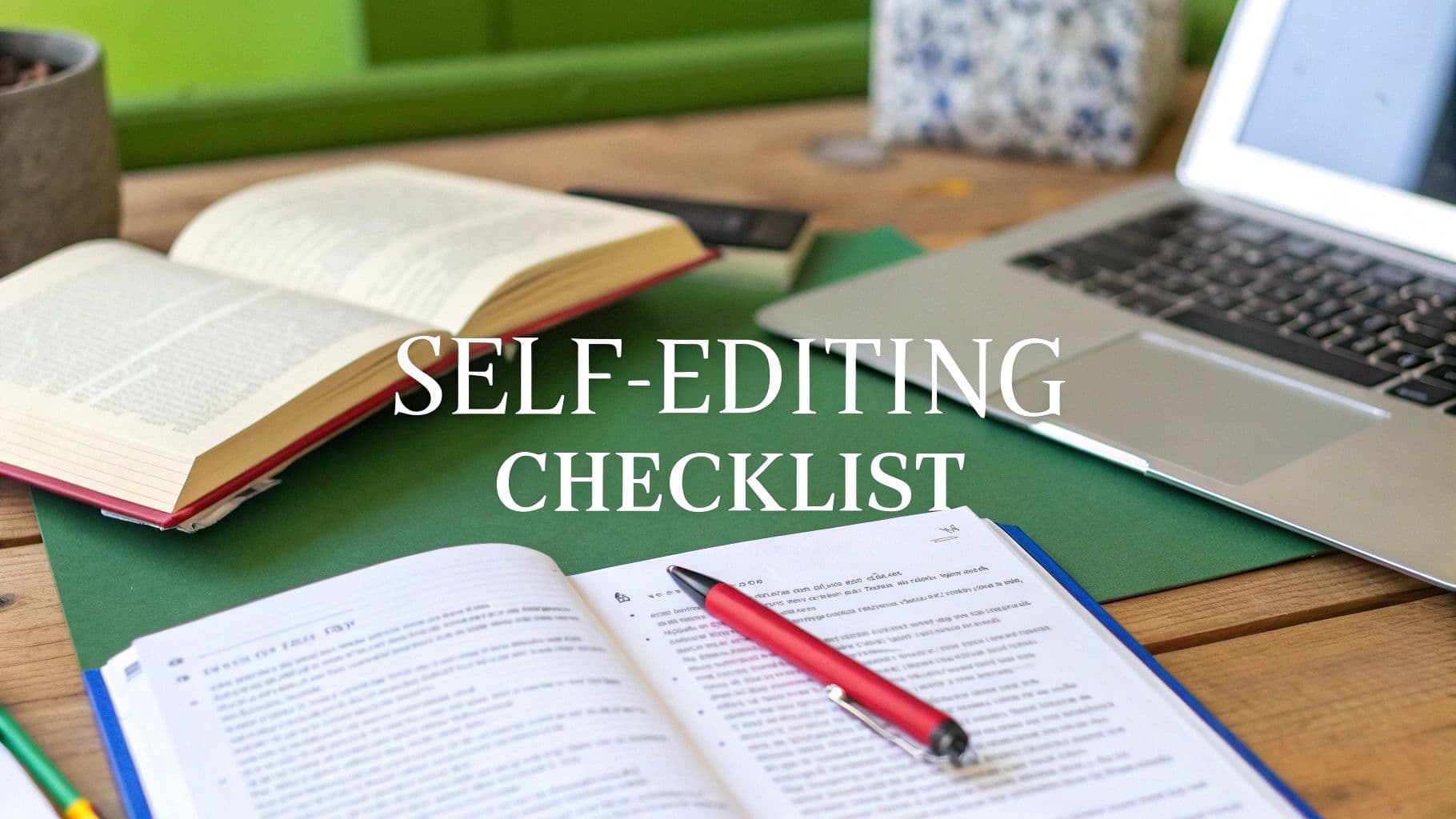
The Ultimate Self Editing Checklist: 8 Steps for 2025
July 4, 2025
The journey from a raw first draft to a polished, impactful piece of writing is paved with careful revision. Many writers, from students to seasoned professionals, often struggle with this final, crucial stage, overlooking small errors that can undermine their entire message. The difference between good and great writing isn't just about the initial ideas; it’s about the meticulous process of refinement that follows. This is where a structured approach becomes your most powerful tool.
A comprehensive self editing checklist acts as your personal quality control system. It guides you through a systematic review covering everything from high-level structural issues to the smallest punctuation mark, preventing you from getting lost in the weeds or missing critical flaws. A systematic process ensures nothing falls through the cracks.
In this guide, we'll break down the 8 essential stages of self-editing that will transform your process. You will learn how to move beyond basic spell-checking to rigorously assess structure, clarity, consistency, and flow. We will provide actionable steps and real-world examples to help you master the art of polishing your own work, ensuring it is not only error-free but also clear, compelling, and ready for your audience.
1. The Big Picture: Mastering Structure and Organization
Before you dive into correcting commas or polishing sentences, take a step back and examine your document's architecture. This initial, high-level review, a crucial first step in any effective self editing checklist, focuses on the logical flow of your ideas. It ensures your argument progresses coherently from the introduction to the conclusion, creating a unified piece that guides the reader without confusion.
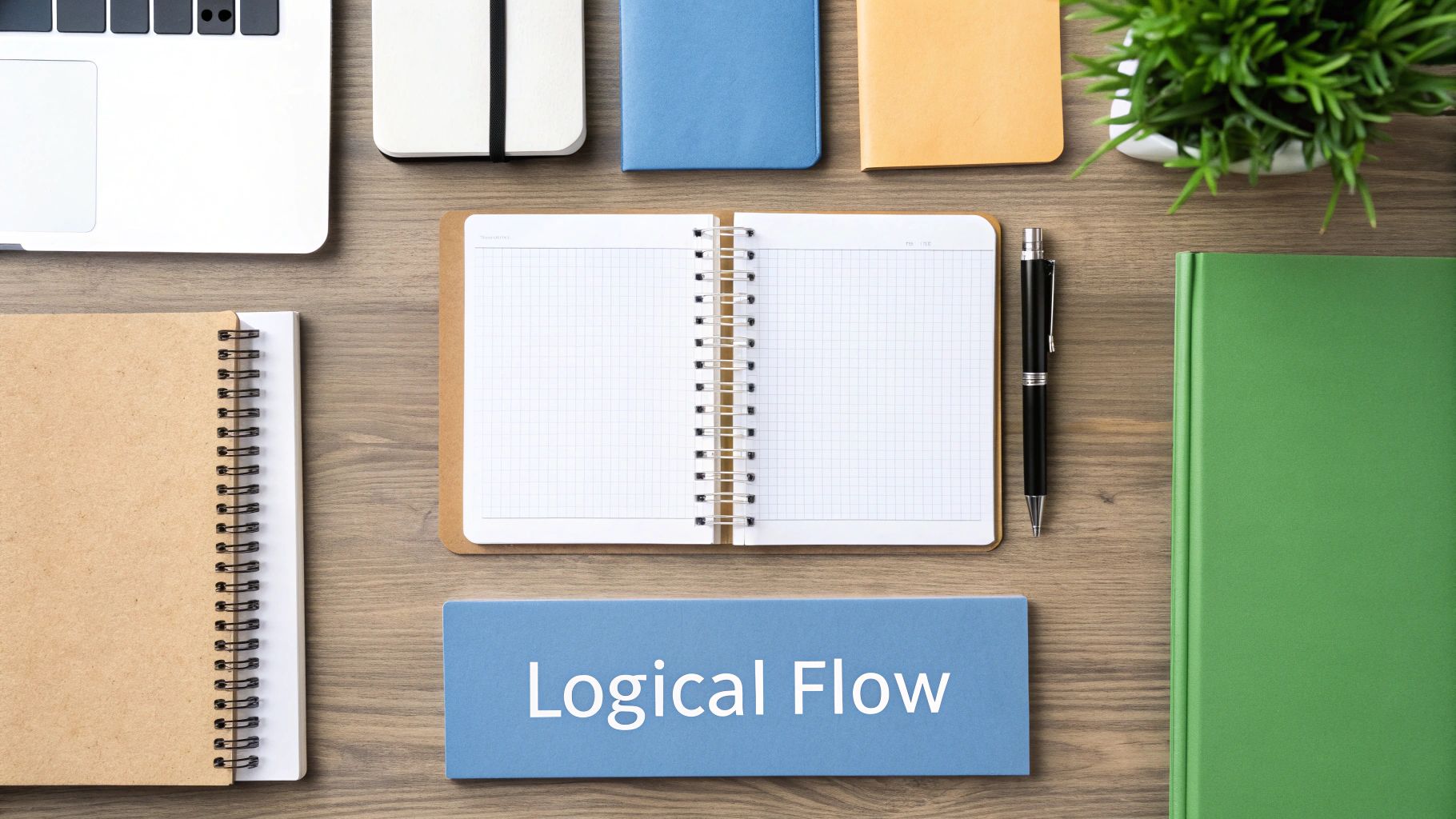
Think of it as checking the blueprint of a house before painting the walls. A strong structure supports your entire message, while a weak one will cause even the most elegant prose to collapse. This structural edit is about confirming that every section and paragraph has a clear purpose and contributes directly to your main thesis.
How to Check Your Structure
This process, popularized by writing authorities like William Zinsser and Ann Handley, involves verifying that your content follows a logical framework. For example:
- Academic papers often use the IMRAD structure (Introduction, Methods, Results, and Discussion) to present research clearly.
- Business proposals succeed with a flow that includes an executive summary, a problem statement, a proposed solution, and an implementation plan.
- Blog posts might leverage the AIDA model (Attention, Interest, Desire, Action) to engage readers and drive conversions.
Actionable Tips for a Structural Edit
To systematically improve your document's organization, try these techniques:
- Reverse Outlining: After writing your draft, create an outline from it. Summarize each paragraph in a single sentence. This reveals your document's actual structure, not just the one you intended, making it easy to spot illogical jumps or misplaced ideas.
- Read Topic Sentences: Read only the first sentence of each paragraph in order. Do they form a coherent, logical summary of your entire piece? If the flow feels disjointed, your paragraphs may need reordering.
- Check Thesis Support: For every paragraph, ask, "How does this support my central argument or thesis?" If a paragraph doesn't have a clear answer, it might be irrelevant filler that should be cut or revised.
For those working on academic pieces, mastering this stage is non-negotiable. To dive deeper into this foundational skill, you can find more guidance on how to build a research paper outline that holds up to scrutiny. A solid outline is the ultimate tool for a strong structural edit.
2. Grammar and Syntax: The Foundation of Clarity
Once your structure is solid, the next step in your self editing checklist is to zoom in on the technical foundation of your writing: grammar and syntax. This stage involves correcting grammatical errors, fixing awkward sentence structures, and resolving punctuation issues. It ensures your ideas are not just well-organized but also communicated with precision and professionalism.
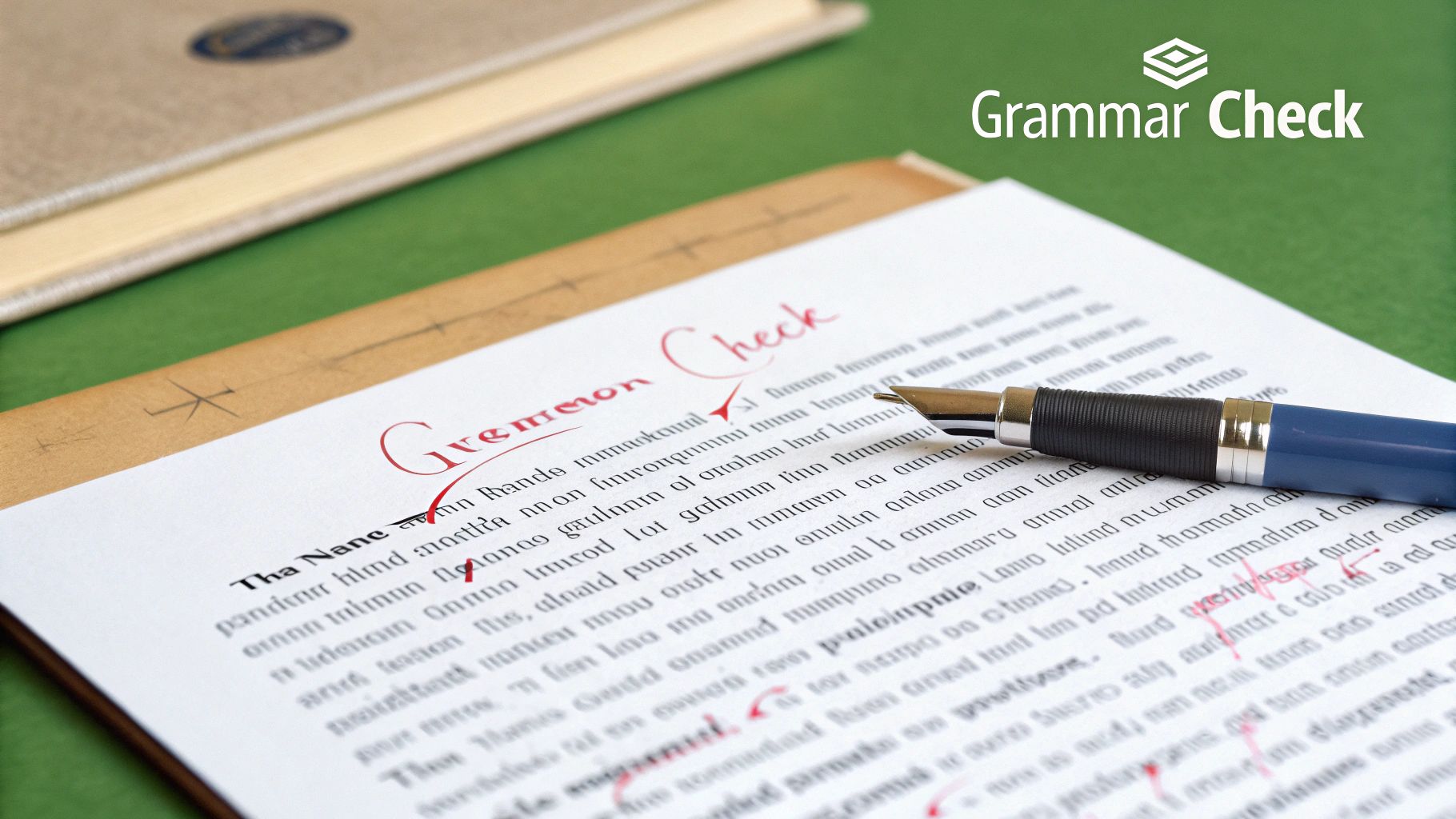
Think of grammar as the set of rules that governs language, and syntax as the artful arrangement of words within a sentence. Mastering both prevents misinterpretation and builds credibility with your reader. Flawless grammar makes your writing invisible in the best way, allowing your message to shine through without distraction.
How to Check Your Grammar and Syntax
This process, championed by grammar experts like Lynne Truss and formalized in style guides like Turabian's, involves a meticulous review of your sentences. Digital tools like Grammarly and ProWritingAid have also made this step more accessible.
- Legal documents depend on precise syntax to prevent loopholes and ensure the intended meaning is legally binding.
- Technical manuals require unambiguous grammar where clarity is directly linked to user safety and successful operation.
- Academic journals enforce strict adherence to grammatical rules and style guides to maintain scholarly standards.
Actionable Tips for a Grammatical Edit
To systematically polish your prose, apply these focused techniques:
- Read Aloud: This is the simplest yet most effective trick. Reading your sentences out loud helps you hear awkward phrasing, clunky constructions, and run-on sentences that your eyes might miss.
- Use Tools as a First Pass: Run your document through a grammar checker to catch common mistakes like subject-verb disagreement or improper tense. However, always follow up with a manual review, as these tools can miss context.
- Focus on One Error Type: Instead of trying to fix everything at once, dedicate separate read-throughs to specific issues. Check for comma splices on one pass, then check for pronoun consistency on the next.
- Keep a Personal Error Log: Note the mistakes you make frequently. Being aware of your common pitfalls (like mixing up "its" and "it's") helps you spot and correct them more efficiently in future projects.
3. Clarity and Conciseness
After confirming your structure is sound, the next vital step in any self editing checklist is to refine your language for clarity and conciseness. This is the art of expressing your ideas in the most direct, understandable way possible. It involves stripping away unnecessary words, untangling complex sentences, and ensuring that every single word serves a distinct purpose in delivering your message.

Think of this stage as decluttering your prose. Just as a minimalist space feels more focused and impactful, concise writing allows your core ideas to shine without distraction. This process transforms your draft from a collection of words into a powerful communication tool that respects your reader's time and attention.
How to Check for Clarity and Conciseness
This principle has been championed by writing coaches like Roy Peter Clark and is the foundation of the Plain Language Movement. Its effectiveness is seen everywhere:
- Government initiatives use plain language to make complex policies and regulations accessible to the general public.
- Tech companies simplify user agreements and privacy policies, moving away from dense legalese to build trust.
- Medical forms are rewritten for patient comprehension, ensuring people can make informed decisions about their health.
Actionable Tips for a Clarity Edit
To systematically tighten your writing and boost its impact, apply these focused techniques:
- Prioritize the Active Voice: Whenever possible, use the active voice ("The team launched the project") instead of the passive voice ("The project was launched by the team"). Active voice is more direct, engaging, and often uses fewer words.
- Eliminate Filler Words: Hunt down and remove empty words that add nothing to your meaning. Words like very, really, just, quite, and actually can almost always be deleted without consequence.
- Simplify Your Word Choices: Replace complex or pretentious words with their simpler counterparts. For example, use "use" instead of "utilize," "show" instead of "demonstrate," and "start" instead of "commence."
- Apply the 'So What?' Test: Read each sentence and ask, "So what?" If the sentence doesn't add new, valuable information or directly support your point, it’s a candidate for revision or removal.
Mastering conciseness is a cornerstone of powerful communication. For a deeper look into this and other writing techniques, you can find more guidance on these effective writing strategies that will help you communicate with precision.
4. Consistency and Style
After solidifying your structure, the next critical phase in your self editing checklist is ensuring stylistic uniformity. This step involves maintaining a consistent voice, tone, and set of formatting rules throughout your entire document. It’s about the small details that, when harmonized, create a professional and polished reader experience, preventing jarring shifts in terminology, formatting, or perspective.

Think of this as the branding of your document. Just as a company uses consistent logos and colors, a writer must use consistent style to build trust and authority. Inconsistent capitalization, fluctuating tone, or mixed citation styles can distract the reader and undermine the credibility of your message, no matter how strong the content is.
How to Check for Consistency
This practice is championed by style guide publishers and professional editors who understand that consistency is a hallmark of quality writing. It requires a systematic review of stylistic choices. For example:
- Academic papers must rigidly adhere to a single style like APA, MLA, or Chicago for citations, headings, and terminology.
- Corporate marketing materials follow strict brand guidelines to ensure a unified voice and visual identity across all platforms.
- News organizations rely on standards like the AP Stylebook to guarantee uniformity in reporting, from datelines to punctuation.
Actionable Tips for a Style Edit
To methodically enforce consistency in your writing, implement these powerful techniques:
- Create a Personal Style Sheet: Before you edit, create a simple document listing your specific rules. Note your choices for capitalization (e.g., title case vs. sentence case for headings), number formatting (e.g., writing out numbers one through nine), and key terms to ensure you apply them uniformly.
- Use Find-and-Replace: Leverage your word processor’s find-and-replace function. Search for common inconsistencies, such as alternate spellings of a term (e.g., "e-commerce" vs. "ecommerce") or punctuation habits (e.g., use of the Oxford comma), and correct them globally.
- Check Formatting in Print Preview: Review your document in print preview or as a PDF. This different view can help you spot visual inconsistencies in headings, font sizes, or spacing that you might miss while editing in a standard word processor view.
For academic writers, mastering a specific set of conventions is essential for publication and grading. To build this skill, you can explore a comprehensive academic writing style guide for more detailed instructions. A consistent style is the final polish that makes your work truly professional.
5. Fact-Checking and Accuracy
Beyond grammar and style, the credibility of your writing hinges on its truthfulness. This is where meticulous fact-checking, a non-negotiable step in any serious self editing checklist, comes into play. It involves rigorously verifying every claim, statistic, quote, and piece of data in your document to ensure it is precise, current, and correctly attributed.
Think of yourself as an investigative journalist for your own work. In a world saturated with misinformation, providing accurate and verifiable content is what separates amateur writing from professional, trustworthy communication. This commitment to accuracy safeguards your reputation and builds lasting trust with your audience, whether they are readers, clients, or academic peers.
How to Check for Accuracy
This process, championed by institutions that prioritize integrity like fact-checking organizations and academic bodies, involves a systematic review of all factual information. The standard for accuracy varies by context but the principle remains the same:
- Investigative journalism demands confirmation from multiple, independent sources before publishing a claim.
- Academic research papers must adhere to rigorous peer-review standards, where every data point and citation is scrutinized.
- Medical and scientific writing requires absolute precision, as inaccuracies can have serious real-world consequences.
Actionable Tips for a Factual Edit
To systematically ensure the accuracy of your content, integrate these practices into your editing workflow:
- Verify from Multiple Sources: Never rely on a single source, especially for critical data or controversial claims. Cross-reference information with at least two independent, reputable sources to confirm its validity.
- Keep Detailed Records: Maintain an organized list or spreadsheet of your sources as you write. Include links, page numbers, and access dates. This makes re-checking facts faster and simplifies creating citations.
- Scrutinize Numbers and Dates: Double-check every statistic, date, and calculation. A misplaced decimal or an incorrect year can undermine your entire argument. For complex calculations, re-run them yourself.
- Use Credible Fact-Checking Tools: For timely or contested topics, leverage professional fact-checking websites. Reputable platforms like Snopes, PolitiFact, and FactCheck.org are excellent resources for verifying public claims.
Ultimately, fact-checking is about upholding your end of the bargain with the reader. By presenting information that is demonstrably true, you honor their trust and establish yourself as a credible authority on your topic.
6. Audience Appropriateness
Effective writing isn't just about what you say; it's about who you're saying it to. This step in your self editing checklist involves critically evaluating your document to ensure its tone, language, and complexity are perfectly tailored to your intended audience. It means stepping out of your own perspective and into your reader's shoes to guarantee your message is not just received, but also understood and respected.
Think of it as adjusting your communication style for different people in your life. You wouldn't explain a complex work project to a five-year-old using the same terms you'd use with your boss. Similarly, your writing must adapt to its specific context to be effective, whether you're communicating with experts, beginners, or a general audience.
How to Check for Audience Appropriateness
This concept, heavily emphasized by marketing professionals and user experience (UX) researchers, is about aligning your content with reader expectations. The goal is to make your content feel like it was written specifically for them. For instance:
- Medical information for patients uses simple, empathetic language, avoiding clinical jargon, while a paper for healthcare professionals would be dense with technical terminology.
- Technical documentation for end-users focuses on practical, step-by-step instructions, whereas documentation for developers includes API details and code snippets.
- Educational materials are carefully calibrated for different grade levels, adjusting vocabulary, sentence structure, and conceptual depth accordingly.
Actionable Tips for an Audience-Focused Edit
To systematically align your writing with your target readers, use these proven techniques:
- Create an Audience Persona: Before editing, define your ideal reader. What is their knowledge level on the topic? What are their goals and pain points? What is their cultural context? Keeping this persona in mind helps you make consistent choices about tone and terminology.
- Test with Representative Readers: Ask someone who fits your target audience profile to read your draft. Their feedback is invaluable for identifying confusing passages, inappropriate tone, or unfamiliar jargon you may have overlooked.
- Perform a "Jargon Sweep": Read through your document specifically looking for technical terms, acronyms, or industry-specific slang. For each one, ask: "Will my defined audience understand this without explanation?" If not, either define it clearly or replace it with a simpler alternative.
This focus on the reader is a cornerstone of powerful communication. By ensuring your content is appropriate for its intended audience, you transform it from a simple broadcast into a meaningful connection, making this a vital checkpoint in any thorough self editing checklist.
7. Spelling and Punctuation
After refining the bigger picture elements like structure and clarity, it's time to zoom in on the foundational mechanics of writing. This meticulous review of spelling and punctuation is a non-negotiable step in any professional self editing checklist. It ensures your document is polished, credible, and free from errors that can distract readers or, worse, alter your intended meaning.
Think of this stage as the final inspection of a product before it ships. Even minor typos or a misplaced comma can signal carelessness and undermine your authority. Adhering to orthographic accuracy is a sign of respect for your reader and your message, ensuring your work is perceived as professional and trustworthy.
How to Check Your Spelling and Punctuation
This process, long championed by the publishing industry and copy editors, involves a systematic scan for typographical errors, misspellings, and incorrect punctuation. The goal is to present a flawless final draft. For example:
- Legal documents demand absolute precision, as a single misplaced comma can change the legal interpretation of a clause.
- Marketing materials rely on perfect presentation to uphold brand quality and professionalism, as errors can damage credibility.
- Academic submissions are judged on their rigor, and poor spelling and punctuation can negatively impact a grade, regardless of the quality of the ideas.
Actionable Tips for a Spelling and Punctuation Edit
To catch every last error, move beyond a simple automated spell check with these proven techniques:
- Read Backwards: Read your document from the last word to the first. This disrupts the natural reading flow, forcing your brain to focus on individual words rather than the meaning of sentences, making it easier to spot spelling mistakes.
- Print It Out: Viewing your text on paper can help you see it with fresh eyes. Errors that are easily missed on a screen often become glaringly obvious on a printed page.
- Use Multiple Tools: Don't rely on just one spell checker. Use your word processor's built-in tool, then run the text through a secondary grammar checker or an online dictionary to catch what the first one missed.
- Take a Break: Step away from your document for at least a few hours, or even a day, before proofreading. This mental distance helps you return with a more critical and objective perspective, making it easier to identify errors you previously overlooked.
8. Flow and Transitions
After refining individual sentences, zoom back out to assess how they connect to one another. Flow is the invisible current that pulls your reader through the text, making the journey from one idea to the next feel effortless and logical. A piece with good flow reads smoothly, while one without it feels choppy, disjointed, and difficult to follow, causing readers to lose interest.
This step in your self editing checklist is about weaving your sentences and paragraphs into a cohesive tapestry. Strong transitions act as signposts, showing the relationship between your ideas, whether it's cause and effect, contrast, or simple progression. This creates a seamless reading experience that guides your audience naturally.
How to Check Your Flow
This technique, a cornerstone of creative writing instruction and modern content strategy, involves auditing the connections within your text. The goal is to ensure each new piece of information builds logically on what came before it. For example:
- Magazine articles excel at transitioning between narrative anecdotes and factual explanations without jarring the reader.
- Academic papers depend on clear logical bridges like "consequently," "in contrast," or "furthermore" to connect complex arguments.
- Narrative non-fiction uses temporal or thematic links to create a compelling, page-turning momentum.
Actionable Tips for a Flow Edit
To systematically improve your document’s rhythm and coherence, try these proven methods:
- Read It Aloud: This is the single most effective way to identify awkward phrasing and abrupt shifts. Your ear will catch what your eye misses. If you stumble or pause while reading, that section likely needs a smoother transition.
- Use Transitional Phrases Sparingly: Words like "however," "therefore," and "in addition" are useful, but overuse can make your writing feel robotic. Use them only when the logical connection isn't already clear from the context.
- Check Paragraph Hooks: Ensure the beginning of a new paragraph links back to the end of the previous one. This creates a chain of thought that guides the reader without interruption.
- Vary Sentence Structure: Mix short, punchy sentences with longer, more complex ones. This creates a pleasing rhythm and prevents your prose from becoming monotonous, which is a key component of effective flow.
8-Point Self-Editing Checklist Comparison
| Aspect | Structure and Organization | Grammar and Syntax | Clarity and Conciseness | Consistency and Style | Fact-Checking and Accuracy | Audience Appropriateness | Spelling and Punctuation | Flow and Transitions |
|---|---|---|---|---|---|---|---|---|
| Implementation Complexity 🔄 | High - requires outlining, rewriting, objective assessment | Medium - requires knowledge of rules, manual + tool checks | Medium - balancing brevity with completeness | Medium - tedious style guide adherence | High - extensive source verification needed | Medium - requires deep audience insight | Medium - detailed proofreading beyond spell-checkers | Medium - subjective, may need restructuring |
| Resource Requirements ⚡ | Time-intensive writing and reviewing process | Grammar tools + expert review | Editing skills and precise language awareness | Style guides, templates, and consistent review | Access to reliable sources and fact-checking tools | Audience research and testing resources | Multiple tools + manual proofreading | Skilled editing and reading aloud |
| Expected Outcomes 📊 | Logical flow, professional tone, reduced confusion | Credibility, readability, publication readiness | Increased engagement, clearer messaging | Professional appearance, reduced confusion | Credible, trustworthy, legally safe content | Effective communication, higher engagement | Error-free, professional presentation | Smooth reading experience, cohesive writing |
| Ideal Use Cases 💡 | Academic papers, business proposals, structured blog posts | Academic journals, legal & technical documents | Government, medical, and tech communication | Academic publications, corporate branding, news writing | Investigative journalism, academic research, medical writing | Marketing, educational materials, UX research | Publishing, legal docs, marketing materials | Magazine articles, academic papers, narrative nonfiction |
| Key Advantages ⭐ | Enhances comprehension and persuasive impact | Prevents confusion, maintains professionalism | Improves comprehension and reduces length | Builds credibility and maintains uniformity | Maintains trust, legal safety, ethical standards | Boosts engagement and connection with target readers | Prevents errors, meets standards, maintains confidence | Improves readability, strengthens argument, reduces fatigue |
Elevate Your Editing with the Right Tools and Mindset
Navigating the journey from a rough draft to a polished final piece requires more than just a quick spell-check. It demands a systematic, multi-layered approach that addresses every facet of your writing. The comprehensive self editing checklist we've explored provides this exact framework, guiding you through the critical stages of refining your work. From the high-level assessment of structure and organization to the granular details of punctuation and spelling, each step is a crucial checkpoint on the path to excellence.
This process transforms your role from merely a writer to that of a meticulous editor. You learn to step back, view your work with a critical eye, and make deliberate choices that enhance its impact. By focusing on clarity, ensuring consistency, and verifying accuracy, you build a foundation of trust with your audience, whether they are academics, customers, or casual readers. Mastering the flow and transitions between your ideas is what elevates a piece from a simple collection of facts to a compelling, persuasive narrative.
The Power of a Hybrid Editing System
While this manual checklist is undeniably powerful, its true potential is unlocked when combined with the right technology. In today's fast-paced content environment, especially with the rise of AI-generated drafts, efficiency is paramount. A manual-only approach can be slow and laborious, but relying solely on automated tools can leave your writing feeling sterile and devoid of a human touch.
This is where a hybrid editing system shines. By integrating an intelligent platform into your workflow, you can automate the more tedious aspects of editing, freeing up your cognitive energy to focus on the higher-level creative and strategic elements. Think of it as a partnership:
- You, the editor, focus on the big picture: Is the argument logical? Is the tone appropriate for the audience? Does the narrative flow compellingly?
- The tool handles the heavy lifting: It catches elusive grammatical errors, suggests more concise phrasing, and ensures your punctuation is flawless.
This synergy allows you to work faster and smarter. It helps bridge the gap between a technically correct piece and one that truly connects and resonates. For anyone working with AI-generated content, this is not just a benefit; it's a necessity for humanizing robotic text and ensuring it aligns with your brand's unique voice.
Your Final Checkpoint: From Good to Unforgettable
Ultimately, a robust self editing checklist is your roadmap to producing consistently high-quality work. It empowers you to take control of your writing, ensuring that every sentence, paragraph, and section serves a clear purpose. It's about developing a mindset of continuous improvement, where each piece you publish is better than the last. Embrace this process, integrate it into your routine, and watch as your writing transforms from merely good to truly unforgettable.
Ready to supercharge your editing process? Go beyond the manual checklist and discover how Natural Write can help you humanize AI text, refine clarity, and perfect your tone with a single click. Elevate your content effortlessly by trying Natural Write today.
